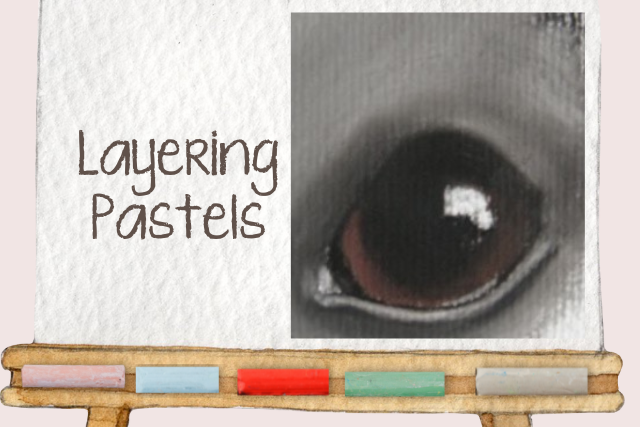I was asked a question the other day about how to layer pastels and what exactly it means.
Simply put – Layering is putting one layer of pastel on top of another.
I see a lot of artists who are new to pastels only ever putting on one or two layers of pastel. Consequently, the painting looks more like a coloured drawing than a painting.
To achieve that painted look in your work, you need depth; to achieve this, the pastel is applied in thin layers.
The image below is a demo of a dog’s eye. It shows how layers have been used to create depth.

As you can see in the first photo, I lay down the initial colour, which I smudge in.
Once that first layer is smudged in, I take the next colour, drag that across the first colour, and blend both colours together. This becomes the second layer. Your second layer can be the same colour as your first; it depends on what you are trying to achieve. Again, this is blended in.
By the third layer, after applying the thin amount of pastel and blending it in, you can see that the paper underneath is starting to disappear. And by the fourth layer….it’s gone altogether.
Do you know how you mix different paints to get the right colour on the palate or a dish before you put it onto the canvas? Well, with pastels, you do the “mixing” on the actual paper.
The key to layering is to keep the layers light or thin. In other words, don’t put too much pastel on and be quite light with the stroke and not heavy-handed.
Another way is to apply all the different colours at once (using the side of the pastels) and then blend.
A lot of artists will use a fixative. Once they have a couple of layers on, they will then lightly spray with fixative. This helps to stop any further layers from blending into the first layers. Personally, I’m not big on fixatives. However, if it works for you, go right ahead.
The number of layers will depend on your paper. If your paper has a good “tooth” (textures that grabs the pastel dust), then you should be able to do a few layers. However, if the paper doesn’t have a great tooth, then the pastel won’t stay on, and the layers will start to slip. Always test your paper to see how many layers it will take before “slipping”.
Layering is not just for the blending technique—all techniques have layering—it’s just one stroke of pastel on top of another. The trick is keeping each layer “thin” using light pressure.
Learning how to layer pastels properly will give depth to your painting and make it feel more like a painting rather than a coloured drawing. Layering the colours of pastels is also wonderful for creating different shades and tones and is a must if you have a limited number of pastels.
There are lots more techniques in the “Pastel Painting Secrets” eBook, or get one of the “Step-by-Step” books.
I’d appreciate you sharing this article




0 Comments